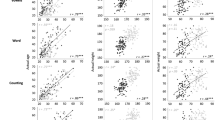Abstract
Selecting the appropriate size of measurement unit in nonverbal research requires empirical as well as conceptual analysis. A definition is offered to distinguish macroscopic from microscopic measurement. Merits of each measurement approach are reviewed briefly in terms of cost, efficiency, precision, and analysis flexibility, and four additional criteria are advocated as central considerations in choosing measurement units: (1) isomorphism between the form of measurement and the phenomenological experience of interactants, (2) reliability, (3) concurrent validity, and (4) predictive validity. These criteria are applied to the analysis of 20 vocalic and kinesic nonverbal behaviors measured microscopically and macroscopically. Reliability and validity results demonstrate that either approach may be acceptable for many behaviors, but that relatively molecular coding may be preferable for highly dynamic and “objective” behaviors, while relatively molar coding may be preferable for static behaviors and perceptual judgments.
Similar content being viewed by others
References
Bakeman, R., & Gottman, J. M. (1986).Observing interaction: An introduction to sequential analysis. New York: Cambridge University Press.
Boice, R. & Monti, P. M. (1982). Specification of nonverbal behaviors for clinical assessment.Journal of Nonverbal Behavior, 7 79–94.
Baesler, E. J. & Burgoon, J. K. (1987). Measurement and reliability of nonverbal behavior.Journal of Nonverbal Behavior, 11 205–233.
Bernieri, F. J., Reznick, J. S., & Rosenthal, R. (1988). Synchrony, pseudosynchrony, and dissynchrony: Measuring the entrainment process in mother-infant interactions.Journal of Personality and Social Psychology, 54 243–253.
Birdwhistell, R. L. (1957).Kinesics and context: Essays on body motion communication. Philadelphia: University of Pennsylvania Press.
Brunswik, E. (1956).Perception and the representative design of psychological experiments. Berkeley, CA: University of California Press.
Buck, R., Baron, R., Goodman, N., & Shapiro, B. (1980). Unitization of spontaneous nonverbal behavior in the study of emotion communication.Journal of Personality and Social Psychology, 39 522–529.
Burgoon, J. K., Buller, D. B. & Woodall, G. W. (1989).Nonverbal communication: The unspoken dialogue. New York: Harper & Row.
Burgoon, J. K., Olney, C. A., & Coker, R. A. (1987). The effects of communicator characteristics on patterns of reciprocity and compensation.Journal of Nonverbal Behavior, 11 146–165.
Burgoon, J. K., Kelley, D. L., Newton, D. A., & Keeley-Dyreson, M. P. (1989). The nature of arousal and nonverbal indices.Human Communication Research, 16 217–255.
Burgoon, J. K., Newton, D. A., Walther, J. B., & Baesler, E. J. (1989). Nonverbal expectancy violations and conversational involvement.Journal of Nonverbal Behavior, 13 97–120.
Burgoon, J. K., & Saine, T. (1978).The unspoken dialogue. Boston: Houghton-Mifflin.
Cappella, J. N. (1981). Mutual influence in expressive behavior: Adult-adult and infant-adult dyadic interaction.Psychological Bulletin, 89 101–132.
Cappella, J. N. (1983). Conversational involvement: Approaching and avoiding others. In. J. M. Wiemann & R. P. Harrison (Eds.),Nonverbal interaction (pp. 113–148). Beverly Hills: Sage.
Cappella, J. N. (1984). The relevance of the microstructure of interaction to relationship change.Journal of Social and Personal Relationships, 1 239–264.
Cappella, J. N. (1991). Mutual adaptation and relativity of measurement. In B. M. Montgomery & S. Duck (Eds.),Studying interpersonal interaction (pp. 103–117). New York: Guilford.
Cappella, J. N. & Street, R. L., Jr. (1989). Message effects: Theory and research on mental models of messages. In J. J. Bradac (Ed.),Message effects in communication science (pp. 24–51). Newbury Park, CA: Sage.
Coker, D. A. & Burgoon, J. K. (1987). The nature of conversational involvement and nonverbal encoding patterns.Human Communication Research, 13 463–494.
Ekman, P. (1982). Methods in measuring facial action. In K. R. Scherer & P. Ekman (Eds.),Handbook of methods in nonverbal behavior research (pp. 45–90). Cambridge: Cambridge University Press.
Gottman, J. (1989). Remarks to the Iowa Conference on Personal Relationships, May 14, 1989. Reprinted inIowa/International Network Newsletter, 8, 7–13.
von Hippel, W. (1990).The effects of schemata on memory for instances. Unpublished dissertation: University of Michigan.
Honeycutt, J. M. (1991). The role of nonverbal behavior in modifying expectancies during initial encounters.The Southern Communication Journal, 56 161–177.
McDowall, J. J. (1978). Interactional synchrony: A reappraisal.Journal of Personality and Social Psychology, 9 963–975.
Newtson, D. (1973). Attribution and the unit of perception of ongoing behavior.Journal of Personality and Social Psychology, 28 28–38.
Newtson, D., Engquist, G., Bois, J. (1977). The objective basis of behavior units.Journal of Personality and Social Psychology, 35 847–862.
Patterson, M. L. (1983).Nonverbal behavior: A functional perspective. New York: Springer-Verlag.
Philpott, J. S. (1983).The relative contribution to meaning of verbal and nonverbal channels of communication: A meta-analysis. Master's thesis: University of Nebraska.
Scherer, K. R. (1978). Personality inference rules in personality attribution from voice quality: The loud voice of extroversion.European Journal of Social Psychology, 8 467–487.
Street, R. L., Jr. (1988). Communication style: Considerations for measuring consistency, reciprocity, and compensation. In C. H. Tardy (Ed.),A handbook for the study of human communication: Methods and instruments for observing, measuring, and assessing human communication processes (pp. 139–161). Norwood, NJ: Ablex.
Street, R. L., Jr., & Buller, D. B. (1987). Nonverbal response patterns in physician-patient interactions: A functional analysis.Journal of Nonverbal Behavior, 11 234–253.
Zahn, G. L. (1973). Cognitive integration of verbal and vocal information in spoken sentences.Journal of Experimental Social Psychology, 9 320–324.
Author information
Authors and Affiliations
Rights and permissions
About this article
Cite this article
Burgoon, J.K., Baesler, E.J. Choosing between micro and macro nonverbal measurement: Application to selected vocalic and kinesic indices. J Nonverbal Behav 15, 57–78 (1991). https://doi.org/10.1007/BF00997767
Issue Date:
DOI: https://doi.org/10.1007/BF00997767




